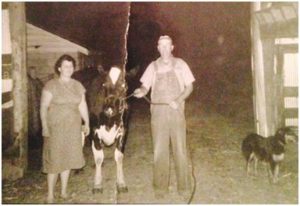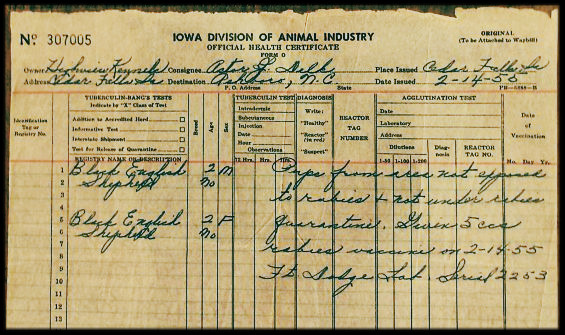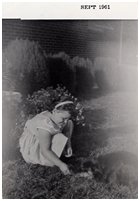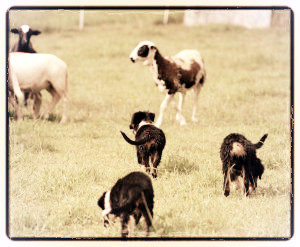by Kay Delk Keziah @2016
 Grandpa and other local farmers (most were dairy farmers) had purebred ESs in the 40’s, 50’s and 60’s.
Grandpa and other local farmers (most were dairy farmers) had purebred ESs in the 40’s, 50’s and 60’s.- Grandpa’s last ES died in the 60’s and later he sold out of the dairy business, but kept farming. He had had beef cows, sheep, goats, horses, chickens and ducks.
- Most of the ESs we had were Black and Tans and the ones in 1955 came from Highview Kennels in Iowa. I still have the bill of laden (pictured below). For some reason, the females were always called “Lady.”

- I do remember one ES that was brown and had a ring round its neck (Brownie), but I’m not sure where this dog was from or what happened to him?
- Grandpa could not find ESs in the late 60’s and early 70’s (no internet). He liked the new neighbors Aussie, a blue merle with 2 blue eyes and a NBBT (natural born bob tail). That dog was very protective. In fact, it was known to bite if you got out when the owner was not home or the children were outside playing in the yard. The Aussie was from the Hartnagle’s in Colorado. He was a real honest working dog on cattle and protective of his family and property.
- ES females were protective of their pups. (I have the scar to prove it on my lip.)
- All our puppies were outside and farm raised.
- When I was about 3 or 4 years old, I was sent to the field with “Lady” to bring the cows in for milking. I’m sure Lady actually did the work. Grandma, who was protective of ME, never thought twice about sending me 1,500 feet down a lane, out of her site, to the field to bring the cows in. They trusted Lady. (And I had fun, cow pies and all!)
- Grandpa trained his ESs on ducks in a stall in the barn (much like I do in a round pen.) He taught ‘left,” “right” and “stop.” The best dogs stayed and worked out their lives on the farm…the other good dogs were sold to neighbors that wanted them.
- Grandpa had a stud dog and at least 1 female at all times. He raised puppies that he sold to local farmers.
- All of Grandpa’s dogs were UKC Registered, some may have been registered with IESR. Sadly, when Grandpa passed in 1994, we threw the registration certificates away. I never thought a thing about the papers until 9 years later.
 Protective of the property, Grandpa’s dogs would warn of strangers and such. Some helped with the squirrel hunting and all helped with the dairy work. His dogs knew their jobs. They didn’t arrive in this world just knowing what to do, though they did have natural herding ability. Even so, they had to be trained to do the jobs Grandpa wanted them to do. He used the ducks early on to teach the dogs what he required.
Protective of the property, Grandpa’s dogs would warn of strangers and such. Some helped with the squirrel hunting and all helped with the dairy work. His dogs knew their jobs. They didn’t arrive in this world just knowing what to do, though they did have natural herding ability. Even so, they had to be trained to do the jobs Grandpa wanted them to do. He used the ducks early on to teach the dogs what he required.- Our English Shepherds did NOT look like Collies. Most had a medium coat length, that suited our area, and all had long tails. Gay tails were not pleasing, but swooping were desired. The Black and Tans usually had some waves in their coat, but sometimes it was straight.
- Amazing stories of saving someone, unless it was from a bull or ram or hog, did not exist.
- The dogs were workers, useful in all ways, pleasing to all, helpful, pleasant and sturdy. I don’t remember the dogs being small and thin boned or short and tiny. They had a distinct look that said “ES!” There were no designer colors. Our ES could, and did, kill snakes and rats in the barn and round the farm. They looked after the chickens by keeping the foxes and hawks run off. They were never far from my Grandpa, their master and the person that fed them. Most stayed on the porch at night and with Grandpa during the day.
- The dogs got their brain, ability to work and reason from the years of selection by stock men and herdsmen that bred for traits. Loyalty, bid-ability, and herding instinct were desired traits that were helpful and needed by the people working the dogs. The size was selected for and dictated by the job the ES did.
 From what I remember, ES noses did not look like Collie noses. ES ears were medium in size and folded over with no prick to them (prick meant BC). Eyes were almond shape and set so if kicked by a cow, they would not loose that eye. ES had enough scull to take that kick and survive, and enough brain to remember to be more careful and do that job in such a way as to NOT be kicked again.
From what I remember, ES noses did not look like Collie noses. ES ears were medium in size and folded over with no prick to them (prick meant BC). Eyes were almond shape and set so if kicked by a cow, they would not loose that eye. ES had enough scull to take that kick and survive, and enough brain to remember to be more careful and do that job in such a way as to NOT be kicked again.- ES would bite stock as needed, but never did they harm an udder or a lamb or calf. I have seen the dogs nose-push a lamb (much like the dogs do us for attention and petting). I’ve also seen them grab a hind leg and hold it so the sheep could be caught, yet not a mark on the sheep!
- Our ES would often find lost lambs and other stock and bring them back.
- Grandpa was always proud of his dogs, their abilities, and their traceable pedigrees.
- The English Shepherds I grew up with were of traceable lineage, had traits that were helpful and needed, looked a certain way (you could look and say “definitely an English Shepherd.”) They were the canine 4-legged version of the 3000 Ford tractor of the same era; steady, ready, helpful, dependable, useful in all ways, cheerful, not flashy, but worked and finished the job no matter what it was.